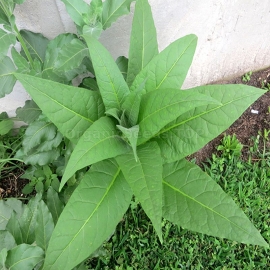 EXCLUSIVE
EXCLUSIVE
«Perique» Heirloom Tobacco Seeds
-
Herloom Tobacco «Perique»
Perique has leaves that are medium-sized, glossy in texture, gummy and tough but have fine fiber with small stems. It has been historically used as a smoking, chewing, cigar, and cigarette variety. It is generally not used exclusively but rather used sparingly in mixes to add body and dimension to a blend.
'Perique' tobacco (the plant) is a specific, unique, variety which you can grow anywhere that tobacco can be grown. However, for clarity sake, there is a tobacco leaf product marketed as "Perique" tobacco. Unless you grow it in Louisiana’s St. James Parish and follow the now centuries-old traditional curing processes, what you grow in your garden will not be Perique the product.
This is not to say that you cannot find success in your garden. We just want to explain the difference between "Perique" the tobacco product and 'Perique' the tobacco variety that both originate from Louisiana's St. James Parish.
The history of the variety dates back to the beginning of tobacco production in St. James Parish. In the late 1700s, a man named Pierre Chenet introduced tobacco cultivation to his fellow Arcadian countrymen. He not only taught them how to successfully grow the crops, but also how to cure and prepare it for market in tightly wrapped rolls called "carottes." In honor of his efforts, they called this plant, and the process, "Perique."
Planting instructions for tobacco plants
Set seedlings outside in filtered sunlight for 2-4 hours per day for a week before planting to acclimate and harden off the tobacco seedlings. Plant seedlings in rows spaced 2 feet in all directions after all danger of frost has passed. Keep soil moist until plants are established. It is normal for plants to wilt after transplanting and appear not to grow at all during the first 2 weeks. All the growth is taking place under ground at this stage. Once established, tobacco requires little water. Fertilize lightly at planting and again in 4-6 weeks only if needed.
Cut off the flower heads when they appear. Topping forces the energy into the leaves making them larger and thicker. Cut off suckers (side branches) when topping. Leaves ripen 2-3 weeks after topping and are ready to harvest when they turn yellow, or become a mottled green and yellow with curled edges.
Harvesting and curing tobacco
Tobacco leaves may be picked as they ripen (primed) and strung on wire or string with ½ inch of space between them for curing. Whole plants can be cut and hung when 50% of the leaves show signs of ripening. Curing (aka color curing) happens when chlorophyll in the leaf breaks down and the leaf changes from green or yellow to brown. Hang leaves or plants in an area where you can maintain a daily average of 70-80% humidity to cure and dry. Basements or outdoor sheds often make great curing locations. If dried to quickly, the leaf will not cure and will dry green. Tobacco that fails to cure and dries green is unsmokable.
After curing, continue to dry the tobacco leaf until it is completely dry and the main stem snaps like a twig. Once cured and dried, the leaf can be left to hang and age where it is, or brought back into case (re-humidified until the leaf is pliable) then packed into cardboard boxes for storage and to age. Aging allows time for nitrogen compounds in the leaf to break down, which removes the harshness of freshly cured tobacco and lets the true flavors come through.
